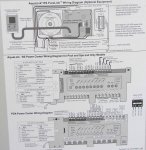- May 3, 2007
- 16,964
- Pool Size
- 20000
- Surface
- Plaster
- Chlorine
- Salt Water Generator
- SWG Type
- Hayward Aqua Rite (T-15)
According to Zodiac tech support, the PS4 & 6 support automatic switching between low speed and high speed when solar is engaged. It is hard wired (not configurable) and isn't documented in the manual.
Also, they make an upgrade kit which is basically a swap of the power center board to go from a PS4 to a PS6 to get extra relays.
Since the Aqualink system supports separate run times for high speed and low speed, the controller can be setup for just low speed and when solar kicks on, it will automatically switch to high speed.
Next, to save on energy, the pump could be easily downsized with a change of impeller and just keeping the existing motor. The motor would draw less power on high speed when solar is running. How far it can be downsized is dependent on the configuration of both the pool plumbing and the solar plumbing. Pipe sizes, run lengths, etc.
However, if the desire is to run on low speed with solar, that is a whole different animal but it can be done you just need to understand some of trade offs.
Also, they make an upgrade kit which is basically a swap of the power center board to go from a PS4 to a PS6 to get extra relays.
Since the Aqualink system supports separate run times for high speed and low speed, the controller can be setup for just low speed and when solar kicks on, it will automatically switch to high speed.
Next, to save on energy, the pump could be easily downsized with a change of impeller and just keeping the existing motor. The motor would draw less power on high speed when solar is running. How far it can be downsized is dependent on the configuration of both the pool plumbing and the solar plumbing. Pipe sizes, run lengths, etc.
However, if the desire is to run on low speed with solar, that is a whole different animal but it can be done you just need to understand some of trade offs.



